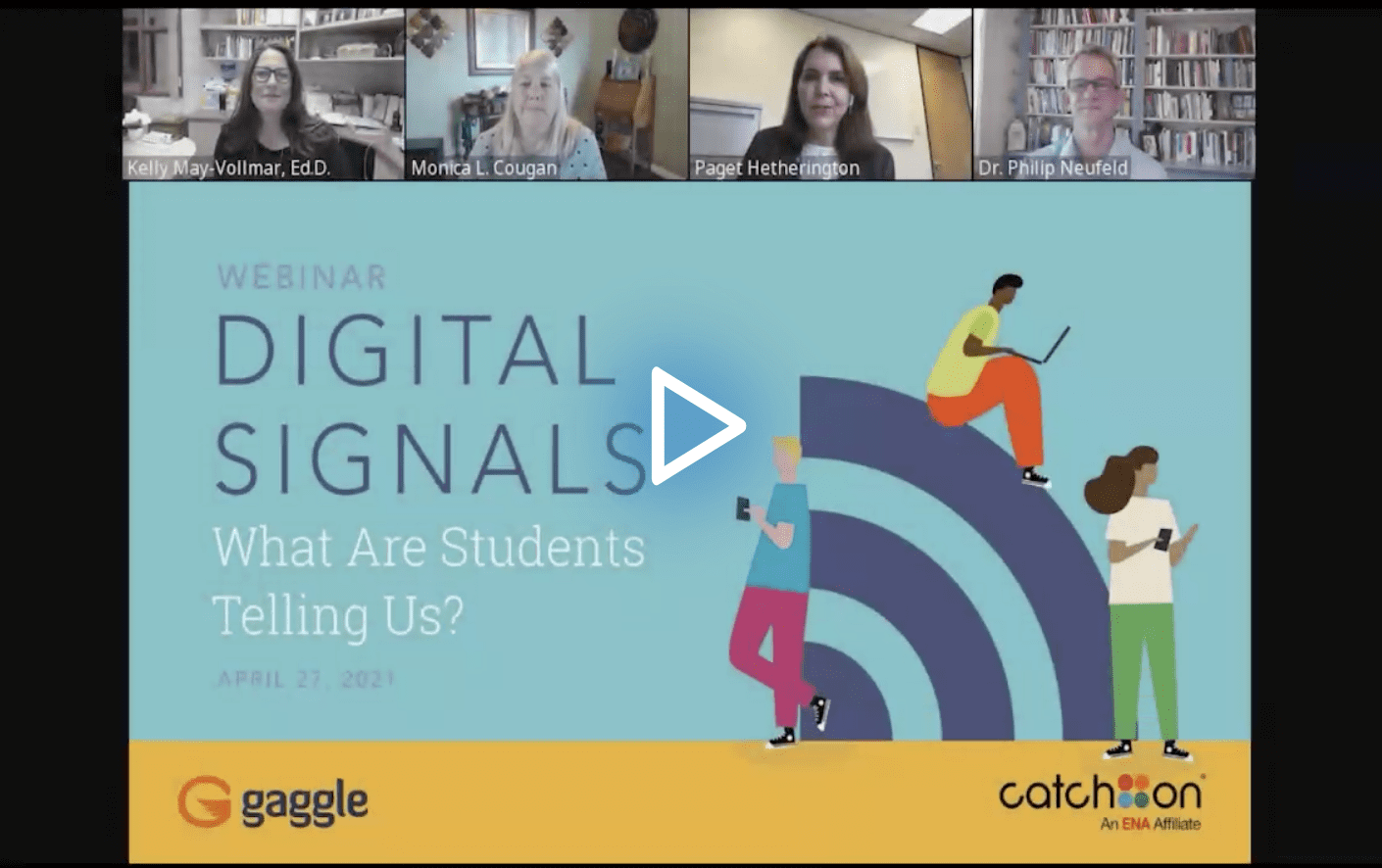Reading Students Through a Tech Lens
Online and far away. That’s what it felt like for teachers and students when COVID propelled them into the digital world. They wondered: Would it be possible for students to learn effectively outside of the classroom? Could instruction be adapted to keep learners engaged from afar? Could schools support student well-being at a distance?
The answer to these questions is yes, so said educational leaders and edtech specialists in an edLeader Panel, sponsored by Gaggle and CatchOn, An ENA Affiliate. They described how districts and schools successfully used sophisticated technology to read students’ “digital signals” to meet their academic and social-emotional needs.
Data: The Driving Force
Evidence of student learning, achievement and engagement is more pronounced and easier to manage in schools. Virtually, it’s all a bit harder to wrangle.
But analytics tools, like CatchOn and Gaggle, helped schools and districts during the pandemic to aggregate data to monitor how learners fared digitally. Looking at variables such as student connectivity (and when that happened), virtual engagement, time spent on learning events and access to collaboration and productivity tools like Google Suite, Zoom and Khan Academy informed approaches to instruction and support systems.
Monica Cougan, Manager of Strategic Relationships and Initiatives at ENA and CatchOn, said CatchOn data underscored schools’ and districts’ desires to facilitate quality synchronous learning experiences for students that fostered continuity and content experiences. The statistics highlighted:
- Learning and instructional gaps (with an eye toward equity)
- Usage and engagement trends, an indicator of the urgency to evaluate the impact of remote, hybrid and on-site learning environments
- Engagement metrics keeping a pulse on the continuity of online and distance learning
- Ways schools districts have used the digital signs to inform changes and best practices and effectively prepare students for college, career and life
- In some instances, risky or unsafe tools or applications students logged into
Data are critical to decision-making, explained Philip Neufeld, Ed.D., Executive Officer at Fresno Unified School District in California.
“I can look at online use of schoolwide tools and make leadership moves that will support instruction, said Dr. Neufeld. “I can see a clear difference between teachers who made a certain amount of time on i-Ready lessons and those who didn’t, and also those who used online platforms to capture student response and those who didn’t, and what that means to student learning.”
Digital Mental Health Signals, Too
Being able to monitor students’ socio-emotional status during COVID was crucial. Technology, in this case, proved to be (sometimes literally) a lifesaver.
Gaggle, a tech tool that helps schools ensure student well-being and safety, was a favored tool of choice in this regard.
Dr. Kelly May-Vollmar, Assistant Superintendent of Educational Services at Desert Sands Unified School District in California, explained that Gaggle’s notification system alerted schools to struggling students who then received support and services to mitigate risk. The “digital signals” of student distress led to an all-staff training on trauma-informed practices to help students in their time of need.
It also strengthened Fresno’s practices, supports and technology for student safety, well-being and engagement, said Dr. Neufeld. The tool’s system identifies and analyzes incidents (using words and phrases drawn from data in tools like Office 365, OneDrive, email and Teams chat) to determine whether they require attention. And if they do, district leaders and an after-hours professional response team speedily address the situation.
Interventions in this construct, emphasized Dr. Neufeld, have occasionally been lifesaving. And in general, have improved student safety and enabled staff to have conversations with students about better interacting in digital spaces.
Changing Practices
Digital signals have propelled instructional and institutional changes. Educational leaders and teachers have improved processes to improve instruction, learning and institutional systems.
For example, Dr. May-Vollmar’s district better investigates students’ online absences, exploring whether technology or connectivity issues prevented access (instead of assuming they just didn’t show up). Or whether the students were ill or just caught up in other pandemic-driven circumstances that were beyond their control.
The district increased its data monitoring to see what students were doing and using online, especially when they were not in a Zoom class. It provided insight into when students were doing homework or logging in (typically later in the evening). That prompted a move to implement delayed school start times, a project that was set to launch in 2022-2023, but the data indicated students were ready for the change sooner.
In Dr. Neufeld’s district, data took on new meaning. It was no longer centered on formative or summative assessment alone; the virtual learning environment presented numerous data points that were no longer “right in front of you.”
To better capture those data and understand their impact, the district has begun to work on predictive models to determine, for example, how decreased digital engagement reflects changes in attendance and how that change shines a light on student well-being.
In both districts, professional development centers on learning how to use digital signals to inform instruction and learning. They are revisiting how assignments are created and completed, how students respond to virtual learning experiences, and how to create virtual and on-site learning environments that respect and balance the different ways students engage and collaborate (some do it better online than they ever did in the classroom).
It’s said that COVID has changed education forever. If you pay attention to the digital signals, you know that statement rings true.
It certainly does for Dr. May-Vollmar, who sees tremendous opportunity for continued growth. “We’ve got to be really intentional that those silver-lining pieces move forward,” she urged, “or some of the very meaningful ways that we have moved forward will digress. We have to all carve out some time in our day to pause and reimagine.”
This edWeb broadcast was sponsored by Gaggle and CatchOn, An ENA Affiliate
Watch the Recording Listen to the Podcast
About the Presenters
Philip Neufeld, Ed.D. is the Executive Officer at Fresno Unified School District. He has served in technology and leadership roles in healthcare, agriculture, banking, and education. Dr. Neufeld left the private industry to work for Fresno State with 25,000+ students, and then Fresno Unified with 72,000 students. Leadership roles include core infrastructure, enterprise services, co-leading a personalized learning initiative with 1,000+ teachers, and co-leading global learning analytics collaborative. Dr. Neufeld shapes educational ecosystems to better prepare students with knowledge, skills, and agency for their #AsYetImagined futures. Dr. Neufeld has an M.B.A. and Ed.D. from California State University, Fresno.
Dr. Kelly May-Vollmar has worked in education since 2004. She served as a classroom teacher, academic coach, site principal, and chief innovation and information officer (CIIO) prior to starting her current position as Assistant Superintendent of Educational Services. She served as CIIO for Desert Sands Unified School District for three years. For the last two years, she has served as the assistant superintendent over educational and technology services. Her experience has allowed her to marry the technology and the educational services departments. As a technology leader in California, she has had the honor of receiving several awards. She was awarded the Association of California School Administrators (ACSA) California Technology Administrator of the Year award in 2019 and the California IT in Education (CITE, formerly CETPA) Educational Leader of the Year award in 2020. Most recently Dr. May-Vollmar was awarded the Community Leadership for Digital Equity Award: Desert Sands Unified School District from CoSN (the Consortium for School Networking).
Monica Cougan is the manager of strategic relationships and initiatives at ENA and CatchOn, where she leverages her more than 35 years of experience in education and technology to help schools make the most of new technology. Throughout her career, Monica has been an evangelist for the adoption of technology as a transformative educational tool. She also has extensive experience helping K-12 schools implement 1:1 programs and in disseminating problem-based and project-based learning methodologies that focus on helping each student develop his or her own voice. Throughout Monica’s extensive career, she has sought out the diverse experiences required to know how to implement positive changes in education: she has served as a classroom teacher, adjunct professor, and education consultant for national, technology-based curriculum companies. Away from the classroom, she has served as an independent math consultant, worked in curriculum development, evaluated research on school-based programs, and developed professional learning opportunities for educators looking for a new mastery of technology.
About the Moderator
Paget Hetherington has empowered children to achieve academic success for her entire career, leading sales and marketing efforts for global publishing and EdTech companies. As the vice president of Marketing, Paget’s focus is spreading Gaggle’s message to school districts across the country, helping to ensure the safety and well-being of students. Prior to Gaggle, Paget led marketing efforts with industry sector leaders VitalSource, Mimio, Lexia Learning, Houghton Mifflin Harcourt, Dorling Kindersley, and Vivendi Universal Publishing.
Join the Community
Analytics in Action is a free professional learning community on edWeb.net for school technology leaders, superintendents, and curriculum and instructional leaders designed to foster collaboration across schools and districts nationally.
Gaggle is the pioneer in helping K-12 districts manage student safety on school-provided technology. Our mission is to help ensure the safety and well-being of all students, supporting school districts in proactively identifying those who are struggling. We have helped hundreds of districts avoid tragedies and save lives, while also protecting their liability.
CatchOn is a user-friendly data analytics tool that collects real-time data on every device, enabling school districts to make data-informed decisions about the apps and online tools their educators and students are using. In 2018, CatchOn joined forces with ENA, a leading provider of comprehensive technology solutions to education institutions and libraries across the nation. Collectively, CatchOn and ENA leverage their respective resources and expertise to deliver critical services and solutions that help school districts produce positive outcomes in the communities they serve.
The summary of this presentation was written by Michele Israel.
Michele Israel writes about the ideas and best practices that are shared in edWeb’s edWebinars so they can spread innovative and best practices to the education community. Michele owns Michele Israel Consulting, LLC, which serves large and small educational, non-profit, media, corporate, eLearning, and blended learning organizations to bolster products and programs. Her rich career spans over 25 years of successfully developing educational materials and resources, designing and facilitating training, generating communication materials and grant proposals, and assisting in organizational and program development. In addition to lesson plans and other teacher resources, Michele’s portfolio includes published articles covering a range of educational and business topics.






Comments are closed.